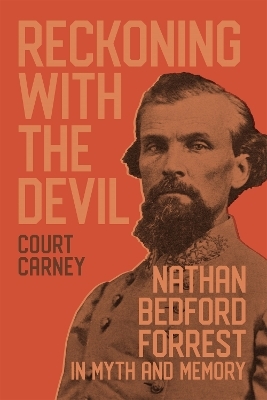
Reckoning with the Devil
Nathan Bedford Forrest in Myth and Memory
Seiten
2024
Louisiana State University Press (Verlag)
978-0-8071-7153-0 (ISBN)
Louisiana State University Press (Verlag)
978-0-8071-7153-0 (ISBN)
Grapples with the troubled, complex legacy of Nathan Bedford Forrest a slave trader, Confederate general, and prominent Klansman. Carney explores how historical omissions and erasures continually reshape perceptions of Forrest as well as the Civil War. Central to Forrest's narrative is his involvement in the slave trade.
Court Carney's Reckoning with the Devil grapples with the troubled, complex legacy of Nathan Bedford Forrest a slave trader, Confederate general, and prominent Klansman. More than a century after his death, Forrest's image continues to resonate with certain groups and bear varied interpretations, reflecting the intricate interplay of history, memory, and a contested past. Carney explores how historical omissions and erasures continually reshape perceptions of Forrest as well as the Civil War.
Central to Forrest's narrative is his involvement in the slave trade, a key to his ascent in the southern social hierarchy. Carney traces Forrest's trajectory from a prosperous slave trader in Memphis to a politician and eventual military leader in the Confederacy during the Civil War. Forrest's postwar years reveal his struggle to rebuild his life, leading him to engage in various economic ventures and eventually join the Ku Klux Klan. Carney argues that the slave trade, the Fort Pillow massacre, and his Klan affiliation were the fundamental elements shaping Forrest's image. Those elements, although steeped in racism and white supremacy, were marked by an ambiguity and malleability that allowed Forrest to attract admirers as well as detractors as his image was memorialized in postwar white southern culture.
Carney covers distinct phases of Forrest's memorialization, from the unveiling of statues in Memphis in 1905 to his representation in literature and media and the controversies surrounding his monuments in the 2010s. That history culminates with the removal of the Memphis statue in 2017, reflecting the evolving societal perspectives on symbols tied to racism. Forrest's significance lies in his capacity to encompass conflicting narratives hero and villain, rebel and patriot. Carney contends that understanding Forrest's legacy is essential for comprehending the intricacies of the southern past and its enduring impact on American society. By exploring the fluidity of Forrest's image, Carney's work illuminates the nuanced interplay of history, memory, and the ongoing struggle to reckon with a tumultuous past.
Court Carney's Reckoning with the Devil grapples with the troubled, complex legacy of Nathan Bedford Forrest a slave trader, Confederate general, and prominent Klansman. More than a century after his death, Forrest's image continues to resonate with certain groups and bear varied interpretations, reflecting the intricate interplay of history, memory, and a contested past. Carney explores how historical omissions and erasures continually reshape perceptions of Forrest as well as the Civil War.
Central to Forrest's narrative is his involvement in the slave trade, a key to his ascent in the southern social hierarchy. Carney traces Forrest's trajectory from a prosperous slave trader in Memphis to a politician and eventual military leader in the Confederacy during the Civil War. Forrest's postwar years reveal his struggle to rebuild his life, leading him to engage in various economic ventures and eventually join the Ku Klux Klan. Carney argues that the slave trade, the Fort Pillow massacre, and his Klan affiliation were the fundamental elements shaping Forrest's image. Those elements, although steeped in racism and white supremacy, were marked by an ambiguity and malleability that allowed Forrest to attract admirers as well as detractors as his image was memorialized in postwar white southern culture.
Carney covers distinct phases of Forrest's memorialization, from the unveiling of statues in Memphis in 1905 to his representation in literature and media and the controversies surrounding his monuments in the 2010s. That history culminates with the removal of the Memphis statue in 2017, reflecting the evolving societal perspectives on symbols tied to racism. Forrest's significance lies in his capacity to encompass conflicting narratives hero and villain, rebel and patriot. Carney contends that understanding Forrest's legacy is essential for comprehending the intricacies of the southern past and its enduring impact on American society. By exploring the fluidity of Forrest's image, Carney's work illuminates the nuanced interplay of history, memory, and the ongoing struggle to reckon with a tumultuous past.
Court Carney is professor of history at Stephen F. Austin State University. He is the author of Cuttin' Up: How Early Jazz Got America's Ear and coeditor of The Politics and Power of Bob Dylan's Live Performances: Play a Song for Me.
| Erscheinungsdatum | 23.08.2024 |
|---|---|
| Zusatzinfo | 13 halftones |
| Verlagsort | Baton Rouge |
| Sprache | englisch |
| Maße | 152 x 229 mm |
| Themenwelt | Geisteswissenschaften ► Geschichte ► Allgemeine Geschichte |
| Geisteswissenschaften ► Geschichte ► Regional- / Ländergeschichte | |
| Geschichte ► Teilgebiete der Geschichte ► Militärgeschichte | |
| Sozialwissenschaften ► Soziologie | |
| ISBN-10 | 0-8071-7153-0 / 0807171530 |
| ISBN-13 | 978-0-8071-7153-0 / 9780807171530 |
| Zustand | Neuware |
| Haben Sie eine Frage zum Produkt? |
Mehr entdecken
aus dem Bereich
aus dem Bereich
neueste Manipulationstechniken als Waffengattung der NATO
Buch | Softcover (2023)
Westend (Verlag)
24,00 €
Deutschlands Schwäche in der Zeitenwende
Buch | Softcover (2023)
C.H.Beck (Verlag)
18,00 €


